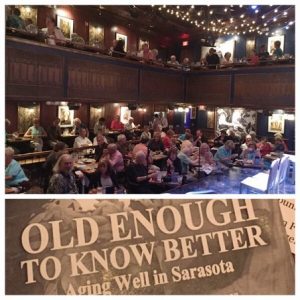Yes
The theatre team solicited feedback throughout the play’s development period by inviting attendees to readings that were followed by question and answer sessions to discuss what was effective and what was missing in the script so that the performance resonated with its audience. Once the script was finalized and put into production, talk-back sessions were held to assess audience response after each of the eight performances during the initial public engagement. The sessions, which were conducted at the conclusion of each performance with theatre-goers who elected to stay after the show, lasted from 12 to 22 minutes with approximately 25 persons per talk-back (i.e., one-quarter of the play’s attendance). A series of open-ended questions were designed to evoke responses from the broad spectrum of audience members (i.e., What was the play about? Did anything in the play surprise you?) The responses provided initial reactions to the production as well as future directions that the company could take with the collected material about aging. Responses to what the play was about yielded considerable discussion among the attendees. Audience members overwhelmingly indicated that the play centered on both “life” and “aging” and felt they “related” to the snippets of stories shared onstage. For example, many audience members reported that the vignettes were about “ordinary people” and that the actors expressed “similar issues” faced in growing older such as the loss of a spouse. The play was viewed as authentic: “(The play) was telling the truth. It spoke the actual voices of those of us here in the community. I think that was so powerful. It was so realistic.” The play prompted attendees to reflect upon their own lives: “I’m in the age group, so these are my stories whether they were my lines or not. These are my stories, my life. It’s not acting, it’s living!” Although the audience was composed predominantly of persons age 65 and upwards, many people exclaimed that they “don’t feel old” and that they felt “validated” by the play: “It was like wow! It validates the experience of getting old, of the feelings that many people have as they age. That we all have different sorts of tears and joys.” Because the performances covered a range of diverse life circumstances and experiences (e.g. single, married, divorced, dating, and widowhood), many theatre-goers conveyed a sense of “choice” about options ahead: “The choices that people are still making in their senior years. Whether to work or not work. Whether to volunteer or not volunteer. Whether to marry. Whether to have a relationship or not.” Many persons expressed positive views about their own aging as noted by the following excerpts: “I got a tremendous amount of optimism about the possibilities (ahead),” “(The play) imparted my life with a lot of positive energy about aging and getting older,” and “I think it was a beautiful portrayal of aging and excitement about the premise of growing old.” Audience members reported they were surprised by theatrical elements of the performance as well as their reaction to the play’s content. The comedic dialogue provided a “lightness” in discussing issues that are oftentimes considered more serious, such as death, and many persons appreciated the “humor” weaved throughout the vignettes: “It surprised me and reminded me how incredibly important it is to be able to laugh at oneself and to laugh at the things that are happening. (The play) hit everything, it didn’t miss a trick and in my experience, you know, some of it was very hard and very difficult, but from this standpoint, I’m able to laugh at it.” Many attendees viewed as particularly poignant the inclusion of quotations on aging from renowned persons such as Winston Churchill and Carl Sandburg. The quotations were inspiring: “My favorite moment is the Gabriel Marquez quote that ‘People don’t stop dreaming because they grow old, they grow old because they stop dreaming’ and that says to me ‘Keep dreaming, keep dreaming.’” The quotations also promoted reflection about our common bonds across time: “People that are no longer with us today, but who faced all the same problems, and their comments are so very relevant to what we all feel.” Attendees echoed a sense of comradery after attending the performance: “I can’t quite articulate why it’s profound, it just is. Even if it’s not your story, it feels like it is your story. I think that goes to the revelation, that we’re all so connected.” Several attendees exclaimed that the play uncovered a newfound and broader view of aging in their community: “I think when you bring people together, all of us as a community experiencing this together, that we all know the same (aging experiences). I haven’t been able to talk to people my own age very much about aging. I’m surprised that everyone else is thinking what I think – that we’re all the same.”
See above…
The Florida Studio Theatre is planning another play based on the interviews collected.


